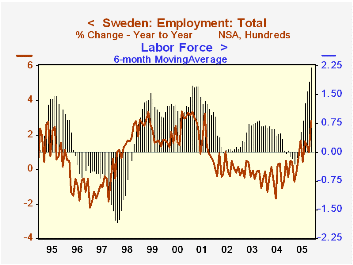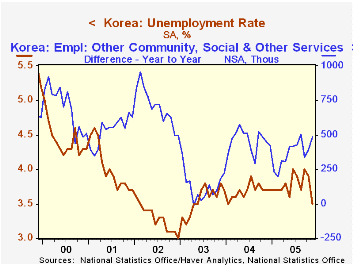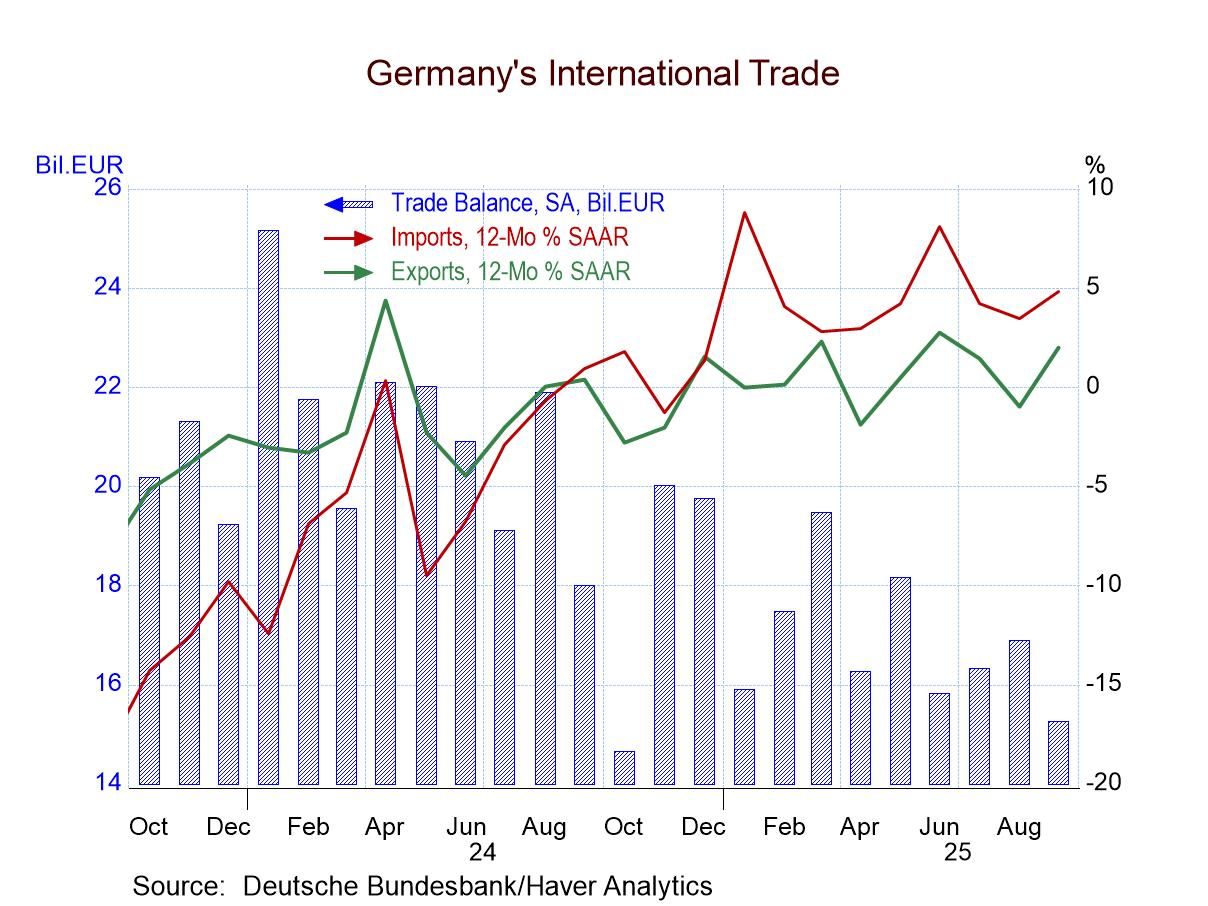 Global| Dec 15 2005
Global| Dec 15 2005Employment Conditions Firm in Netherlands, Sweden & Korea in October, November Data
Summary
Three diverse countries which reported their latest labor fore data today, have shown improving trends in the last couple of months. In the Netherlands, Sweden and South Korea, the most current unemployment rates have decreased and [...]

Three diverse countries which reported their latest labor fore data today, have shown improving trends in the last couple of months. In the Netherlands, Sweden and South Korea, the most current unemployment rates have decreased and employment, while not reaching records, also appears to be on a firm uptrend in each region.
In the Netherlands, employment gained 4,000 in October, following an increase of 33,000 in August and September combined. These data are quoted as 3-month centered moving averages. As shown in the first graph, the first half of 2005 saw a flat pattern for employment, so the recent rise is encouraging even though the level remains well below prior years. The Dutch labor force survey only began in 2000, so there is little history to compare. Unemployment has begun an ever so gradual decline after reaching a high of 6.7% in February and March. Although down only 0.2 percentage point, the improvement looks to be sustainable, since it accompanies rising employment, not the "discouraged worker" syndrome of a shrinking labor force. Indeed, using Excel to calculate a labor force participation rate (those in labor force as a percentage of the sum of the labor force and those not in labor force), we find it at 67.44% in September and October, up from a low of 67.16% in April and the highest so far this year.
In Sweden, employment was up in November by 117,500 from a year ago, in data that are not seasonally adjusted; this extends a firming trend that began in May and represents 2.8% growth in the number of people with jobs. The unemployment rate, at 5.0% last month, is up 0.1% from the year-ago amount, but it accompanies a participation rate that is also rising and is the highest in more than 3-1/2 years. So, here, as in Holland, people are not backing off from the labor force, but joining it. Indeed, the labor force is growing at a record rate by far. In the second graph, we show a six-month moving average of year-to-year growth rates. For November this was 2.2%, a record for this 30-year-old survey. It looks impressive together with the employment growth, indicating resilience of the Swedish labor market.
The situation in South Korea looks a bit different than might be expected. Employment is growing, although not as rapidly as before the currency crisis period of the late 1990s or in the immediate recovery from that in 1999 and 2000. At the same time, a broad industry breakdown into manufacturing and services shows that manufacturing jobs are actually declining and have been all this year, so that the November figure is 107,000 below a year earlier. However, the service sector has been expanding by more than enough to make up for that -- 482,000 over the last 12 months. The unemployment rate has thus been able to come down, reaching 3.5% in November, the lowest since January 2004.
| Employment (thous) Unemployment Rate (%) | Nov 2005 | Oct 2005 | Sept 2005 | Year Ago | 2004 | 2003 | 2002 |
|---|---|---|---|---|---|---|---|
| Netherlands*: Employment | -- | 6,937 | 6,933 | 6,914 | 7,037 | 7,114 | 7,125 |
| Unemployment Rate | -- | 6.5 | 6.5 | 6.6 | 6.4 | 5.3 | 4.1 |
| Sweden**: Employment | 4,304 | 4,238 | 4,259 | 4,186 | 4,213 | 4,232 | 4,242 |
| Unemployment Rate | 5.0 | 5.6 | 5.4 | 4.9 | 5.5 | 4.9 | 4.0 |
| South Korea***: Employment | 23,030 | 22,914 | 22,836 | 22,639 | 22,557 | 22,139 | 22,169 |
| Unemployment Rate | 3.5 | 3.9 | 4.0 | 3.7 | 3.7 | 3.6 | 3.3 |
Carol Stone, CBE
AuthorMore in Author Profile »Carol Stone, CBE came to Haver Analytics in 2003 following more than 35 years as a financial market economist at major Wall Street financial institutions, most especially Merrill Lynch and Nomura Securities. She had broad experience in analysis and forecasting of flow-of-funds accounts, the federal budget and Federal Reserve operations. At Nomura Securities, among other duties, she developed various indicator forecasting tools and edited a daily global publication produced in London and New York for readers in Tokyo. At Haver Analytics, Carol was a member of the Research Department, aiding database managers with research and documentation efforts, as well as posting commentary on select economic reports. In addition, she conducted Ways-of-the-World, a blog on economic issues for an Episcopal-Church-affiliated website, The Geranium Farm. During her career, Carol served as an officer of the Money Marketeers and the Downtown Economists Club. She had a PhD from NYU's Stern School of Business. She lived in Brooklyn, New York, and had a weekend home on Long Island.





